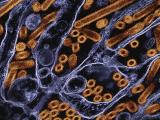Nov 10, 2006 (CIDRAP News) – China said today it would share more avian influenza virus samples, despite reported misuse of some shared previously, and repeated its rejection of a report that a new strain of H5N1 virus has spread through southern China, according to news services.
The World Health Organization (WHO) said China is sending 20 H5N1 avian flu virus samples to the US Centers for Disease Control and Prevention (CDC), Reuters reported today. Henk Bekedam, WHO representative in Beijing, told Reuters the samples are from 2004 and 2005.
China's promise to share more avian flu samples comes on the heels of a WHO apology to China for the misuse of previous samples that the country provided, according to the Chinese news service Xinhua. Jia Youling, China's chief veterinarian, told reporters today that Bekedam had personally apologized to him for the incidents.
Jia said foreign research institutions improperly used Chinese samples in two cases. In one instance, a research paper attributed the Chinese samples to other countries, Xinhua reported. One of the coauthors of the paper, Robert Webster, PhD, of St. Jude Children's Research Hospital in Memphis, also apologized to the Chinese research institution involved, Jia said.
In the second case, foreign researchers cited a Chinese sample without giving credit to the Chinese, which violates international protocol, Xinhua reported.
Jia rebuffed criticisms that China hasn't shared its avian flu samples with the international community. He said the country sent five samples to the WHO in June 2005 and sent the CDC another 20 samples this year.
CDC officials reported in September that 20 samples expected from China had been delayed because of a disagreement over the mailing protocol but that the problem had been resolved. CDC officials could not be reached today to clarify whether the samples were actually received.
It's unclear if the new batch of Chinese samples will shed new light on claims by US and Hong Kong researchers that a new subtype of H5N1 avian flu virus, the "Fujian-like" strain, has become predominant in southern China over the past year. Researchers writing Oct 30 in the Proceedings of the National Academy of Sciences (PNAS) suggested that the strain may be resistant to Chinese poultry vaccines and that it has been found in human H5N1 cases in China.
Chinese officials immediately rejected the study, and Jia repeated that denial today. The Reuters report quoted him as saying, "There is no such thing as a new 'Fujian-like' virus variant at all."
Earlier, in a Nov 6 China Daily report, some of China's leading avian influenza experts asserted that the PNAS report lacked scientific proof. Chen Hualan, director of the National Bird Flu Reference Laboratory at the Chinese Academy of Agricultural Sciences, said genetic analysis showed that the so-called Fujian-like virus "shares high conformity with the H5N1 virus that was isolated in Hunan when bird flu broke out in early 2004." She added that samples from every domestic avian flu outbreak are sent to her lab for isolation and genetic sequencing.
Chen said that in 2005 and 2006 the lab isolated viruses from waterfowl in southern China and reported the results to the United Nations Food and Agriculture Organization (FAO) and the World Organization for Animal Health (OIE). "These viruses all remain steady in gene type, and there is no marked change in their biological characteristics," she said.
Chen also contested the PNAS report's suggestion that the Fujian-like strain may be resistant to the Chinese poultry vaccine. She said the researchers did not specify the locations and vaccination status of the chickens they tested, and pointed to decreasing numbers of avian flu cases as evidence of the vaccine's effectiveness. The Chinese Ministry of Agriculture said 95% of domestic poultry were vaccinated between January and October.
Shu Yuelong, director of the National Influenza Center at the Chinese Centre for Disease Control and Prevention, said the PNAS authors' claim that five people in southern China were infected by the Fujian-like strain was wrong, according to China Daily.
"Fifteen out of the 16 variants were isolated from [human] cases in southern China and they belong to the same gene type. There is no proof that five of them were infected by a new mutated virus," Yuelong said.
See also:
Sep 11 CIDRAP News article "Way cleared for China to share H5N1 samples"
Oct 30 PNAS report on the emergence of a Fujian-like H5N1 influenza virus in China
http://www.pnas.org/cgi/content/abstract/0608157103v1
Nov 3 CIDRAP News article "Study says new H5N1 strain pervades southern China"


















